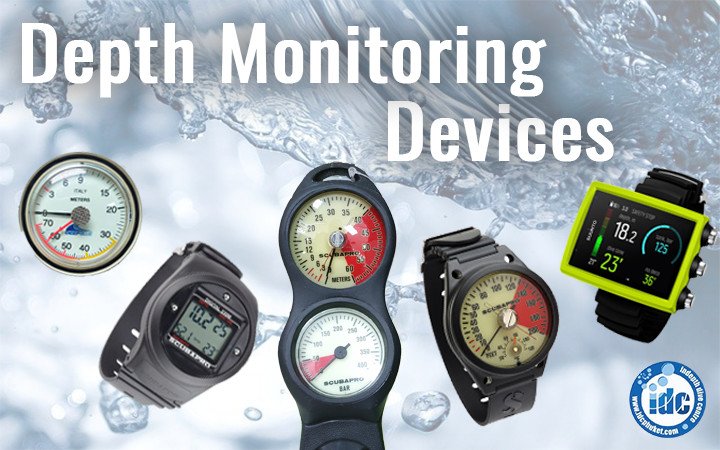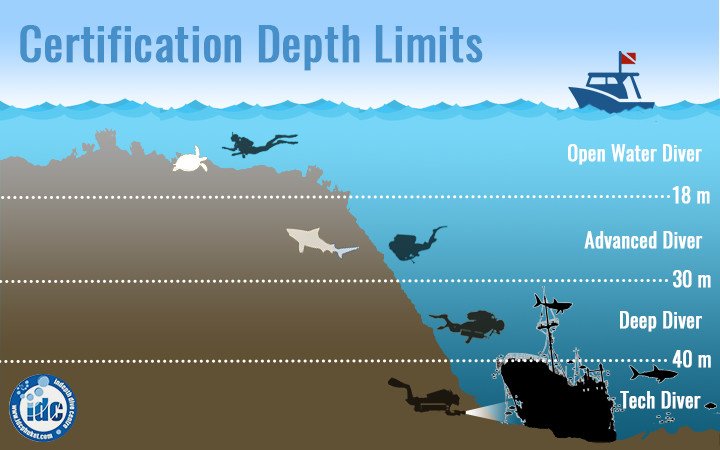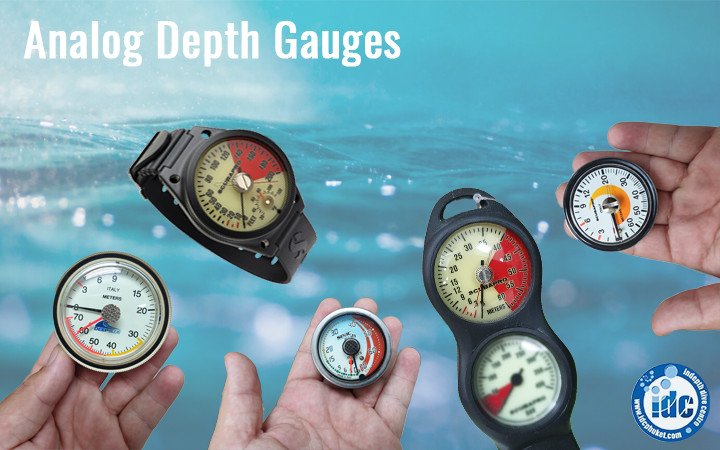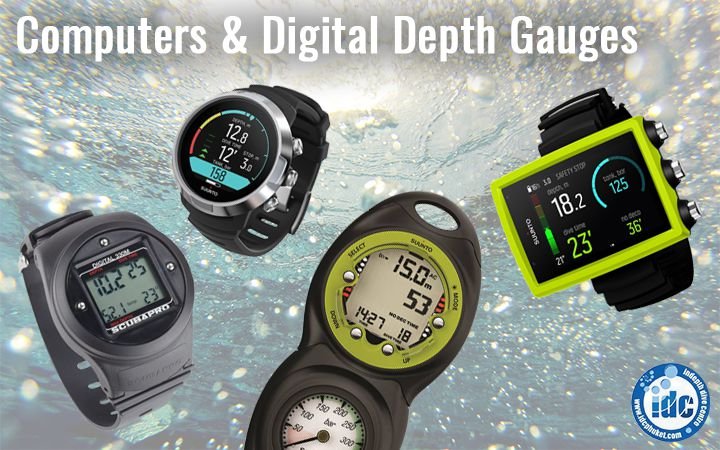Depth Monitoring Devices
A scuba depth gauge or depth monitoring device is a crucial piece of scuba diving equipment. All recreational scuba divers must constantly monitor their depth. There are three safety reasons for this:
- so that you stay within the scope and limits of your training;
- so that you stay within the established no-decompression limits of recreational diving and don’t unnecessarily put yourself at risk of decompression illness; and
- for Enriched Air Nitrox divers, you stay within the allowable and safe operating limits of the gas you are breathing.
Consequently, all divers must carry with them a depth monitoring device. A scuba depth gauge of some sort; whether it be analogue or digital, is considered standard scuba equipment and you cannot safely dive without one. In this blog, we will consider the reasons why a diver must constantly be aware of their depth, the limits placed on you because of depth, how you can extend your depth limits and then look at some of the products available which allow divers to effectively monitor their depth. As always, this is not exhaustive so if you would have any questions about any piece of equipment you are using, would like to book some diving with us, or even learn to dive deeper, please contact us here.
Training and Certification Depth Limits
On your Open Water Course, you would have been aware that during your training you had depth limits and you would have been briefed on those limits by your instructor before each dive. After your pool training, your first open water dives would have been shallower than your final dives. As your course went on your dives would have become progressively deeper in accordance with your skills and experience increasing. You would have also had a scuba depth gauge with you on all dives so even though you were always with your instructor, you could still monitor your own depth throughout the dives.
Open Water Diver Depth Limits
Your maximum depth would have been no more than 18m and at the completion of your course, your instructor would have reminded you that as an Open Water Diver, you are trained to make dives to a maximum depth of 18m. No deeper. Scuba training agencies are very strict when it comes to depth limitations during training and rightly so. With increased depth comes increased risks and the need for additional training.
As a certified Water Diver with a depth limit of 18m, not every recreational dive site will be open for you. The recreational diving limit is 40m but in order for you to make dives on deeper sites, you need to provide evidence of training to that depth. You will only be able to make the dives which fall within the scope of your training; this is for your own safety as well as for those you are diving with.
Taking an inexperienced/untrained diver on a dive which they are not trained for can be dangerous; not only for the diver themselves but places an unnecessary burden on other divers to take care of them. Taking risks and diving beyond your certified depth limit also risks exposing you to stressors and hazards which you are not prepared for, such as gas narcosis. Additionally, many insurance companies won’t support you to take risks or cover you for diving accidents on dives outside of the limits of your training.
With additional training, you learn more advanced methods for gas management and dive planning which become more critical as depth increases. Without proper training, diving deeper unnecessarily increases the risks to your safety. Consequently, a prudent diver is always monitoring their own depth, with a scuba depth gauge, to ensure they always remain within the limits of their training.
Courses to increase your depth limitations
If you want to learn to dive deeper, you must undertake more training and can do so by taking your Advanced Open Water Diver Course for 30m, or Deep Diver Specialty Course which will train and certify you to dive to 40m, which is the recreational diving limit. If 40m doesn’t sound like enough for you, fortunately, you will never run out of courses to take. After you take your Deep Diver Specialty, Enriched Air Nitrox Specialty and Rescue Diver Course, log 50 dives which include at least ten dives on Nitrox, twelve dives deeper than 18m and six dives deeper than 30m, you can begin training as a technical diver.
No Decompression Limits
Recreational Diving
During your Open Water Diver Course, one of the first things you would have learnt about is the no-decompression limit; how to use a recreational dive planner and/or a dive computer to plan your dives within the recreational diving and depth limits. The key factor you must know in order to safely plan your dives is your depth. During the dives themselves, you would have had to constantly monitor your depth to ensure you stayed within these limits. A depth monitoring device is crucial for this purpose.
As recreational divers, it is critical we dive within the depth and no-decompression limits so that in the unlikely event of a problem or an emergency, we are able to immediately end the dive and directly access the surface. Also diving within the established recreational depth limits and the no-decompression limit means as recreational divers, diving with a single tank, we should have a sufficient amount of breathing gas with us for the dive. Once you exceed these limits and depending on by how much, a single tank is no longer enough to get you back to the surface safely.
Technical Diving
Diving beyond the no-decompression limit, or deeper than the recreational depth limit is within the scope of technical diving and beyond the range of recreational diving. Technical divers have a decompression ceiling meaning if they have a problem, they have to fix it at depth. They cannot just surface and doing so will almost guarantee decompression illness. In order for a technical diver to end their dive, they must do planned, mandatory decompression stops and because of their decompression ceiling, they carry significantly more equipment, tanks and redundancies than recreational divers do. None of this would be possible without a depth monitoring device.
A recreational diver exceeding recreational depth limits or the no-decompression limit doesn’t make them a technical diver, it makes them a careless and dangerous diver. Not only do they risk running out of breathing gas, but they also risk decompression illness.
You will hopefully recall from your Open Water Course that there are three factors which determine your no decompression limit:
- The gas you are breathing and the Nitrogen content of that gas. For example, air has a higher fraction of Nitrogen than Nitrox does. Consequently, if you are breathing air, you have a shorter no-decompression limit;
- The amount of time you spend underwater; and most importantly
- Your depth.
Dive Planning
Knowing what depth you plan to dive to before the dive as well as knowing what depth you are at throughout the entire dive is critical to ensuring you remain within the no-decompression limit, as well as the limits of your training. For Nitrox divers, the Oxygen content of their tanks will also determine their maximum allowable depth. Exceeding this can result in oxygen toxicity which is highly dangerous. Continual monitoring of depth is critical to the diver’s safety.
There is no way to assess your depth without using a depth monitoring device by which to do so. As water visibility varies from dive to dive, you can’t simply judge your depth by sight. The better the visibility, the easier it is for divers to see the surface from depth so the harder it becomes for them to judge their actual depth. There are two primary ways divers monitor their depths throughout the dive; with analogue depth gauges and with digital depth gauges or diving computers.
Analog scuba depth gauges
An analogue depth gauge comes in two models; one which is integrated into the diver’s information console, usually above the submersible pressure gauge (SPG) and one which is worn on the diver’s arm, like a computer or compass. Unlike an SPG, a scuba depth gauge does not need to connect to your tank. Instead, the pressure of the surrounding water activates the gauge.
How does it work?
You will hopefully remember Boyle’s Law from your Open Water Course and that the relationship between depth and pressure is constant. With increasing pressure, air spaces are compressed in a consistent and linear fashion which can be measured. For example, at 10m of seawater, the absolute pressure is 2 atmospheres and an air space will be compressed by half.
An analogue gauge works by using Boyle’s Law. In fact, an analogue scuba depth gauge works in a very similar way as which an SPG does. There is a C-shaped air-filled tube inside of the gauge. When the gauge submerges underneath the water surface, water enters the tube and compresses the air space inside it. A pointer/needle attached to the tube will move in accordance with the changes in pressure inside the tube. The needle will point to a number, indicating to the diver what depth they are at. On most analogue depth gauges, there are two pointers; one which shows the current depth and one which records your maximum depth.
Disadvantages
The “maximum depth needle” can easily be reset back to zero by the diver at the end of the dive, or after they have logged their dive, by using a small dial. The disadvantage of recording your dives this way is that the gauge only records one dive at a time. This means that if you are making multiple dives a day, you must record your maximum depth after each dive. A computer, on the other hand, will store all the dives in its memory. You won’t have to log after every dive, the data will still be there at the end of the day.
Analogue gauges are available in both metric and imperial forms so divers can choose to read their depth in metres or feet. A downside of an analogue scuba depth gauge is it is not as accurate as a digital gauge, or computer. It also doesn’t show the diver their exact depth to within 10cm as a digital computer or gauge does. Analogue gauges also have no ability to warn the diver if they exceed a depth limit or ascend too quickly, unlike their digital alternatives.
Like SPGs, analogue depth monitoring devices will glow in the dark after being exposed to light. This allows divers to easily read them in low visibility situations or on night dives.
Dive Computers and Digital Scuba Depth Gauges
Although you can still find digital depth gauges which only read the depth and the time, it is more common and practical these days for divers to simply use a dive computer that has both of these functions and more. Dive computers range from basic models to those which include all the bells and whistles; with prices to match. Entry-level dive computers these days are very affordable and some of them quite stylish. Divers can easily wear them as a watch outside of the water when not diving.
All dive computers monitor the diver’s depth, which can be displayed in either metres or feet. As a computer is electronic, it uses a different mechanism than an analogue gauge to assess the pressure. This allows a very accurate reading of the depth the diver is at any given time. Underwater, most dive computers will read the depth to within 10cm. For example, it will tell you if you are at 12.1m rather than just 12m. The advantage of a dive computer is not only that the computer is monitoring your depth; it knows what gas you are breathing so updates your no-decompression limit in real-time.
Advantages
You will recall from your Open Water Course, one of the limits of using a recreational dive planner (RDP) to plan your dive is the RDP assumes you descend to your maximum depth and then stay there for the entirety of the dive. This doesn’t reflect real life. A computer, on the other hand, is constantly monitoring your depth so will credit your no-decompression limit (NDL), or penalise you, if you ascend or descend slightly. The computer will also warn you once you are near your NDL and tell you that you need to ascend.
Many dive computers also feature depth alarms which the diver can set. For example, if the diver has a 30m certification depth limit, they can set an alarm to warn them once they near their limit. Divers using Nitrox can also use this feature to prevent them from exceeding the MOD of their gas mixture. Most computers, however, will warn you if you get close to the MOD of your gas anyway.
Many computers also include ascent alarms which will beep, flash or vibrate when ascending faster than the safe ascent rate. Computers also store the dive data within them so you can make multiple dives before you need to refer back to the dive log to complete a logbook. Some computers connect directly with PCs so allow for divers to log their dives electronically.
Divers can easily read their computer on night dives and in limited visibility. Some have built-in lights illuminating the screen when needed, while others are constantly lit-up and readable in all conditions.
Disadvantages
A downside of a computer is that it relies on a battery to operate. Some models are able to recharge remotely on charging pads or the diver can easily self-replace their batteries. Many other models instead can only have their batteries replaced in dive shops because they need to be pressure tested. If the battery fails while diving, the diver will have to abort the dive. But then the diver has no mechanism for assessing their ascent rate or measuring their safety stop. They will have to rely on their buddy to safely ascend.
General Considerations – Depth Monitoring Devices
With any scuba depth gauge you purchase or use, the most important consideration is that you are able to clearly read the gauge and understand the information it is giving you. For divers using digital depth gauges/computers, your first step after the purchase must be to read the user manual. There are literally hundreds of different computers on the market so turning up to the dive site and expecting another diver to know what your computer is trying to tell you is risky.
If you haven’t dived for a while or have maybe forgotten some of the theory from your Open Water Course, including dive planning and determining no-decompression limits, we recommend you schedule a ReActivate Course with us to review your theory and skills with an instructor before doing some fun dives and putting them to practice. Likewise, if you want to learn to dive deeper and extend your depth limits, contact us here.
More posts about diving equipment:
- Choosing Dive Equipment
- Choosing a Scuba Diving Mask
- All about snorkels
- Choosing the right fins
- Scuba Cylinders & Valves
- Buoyancy Control Devices (BCDs)
- How to choose a Scuba Regulator
- Breathing Gas Monitoring Devices
- Scuba Diving Weights & Quick Release Weight Systems
- Choosing a wetsuit for Scuba Diving
- Audible Signaling Devices for Scuba Diving
- Choosing a Scuba Diving Compass







